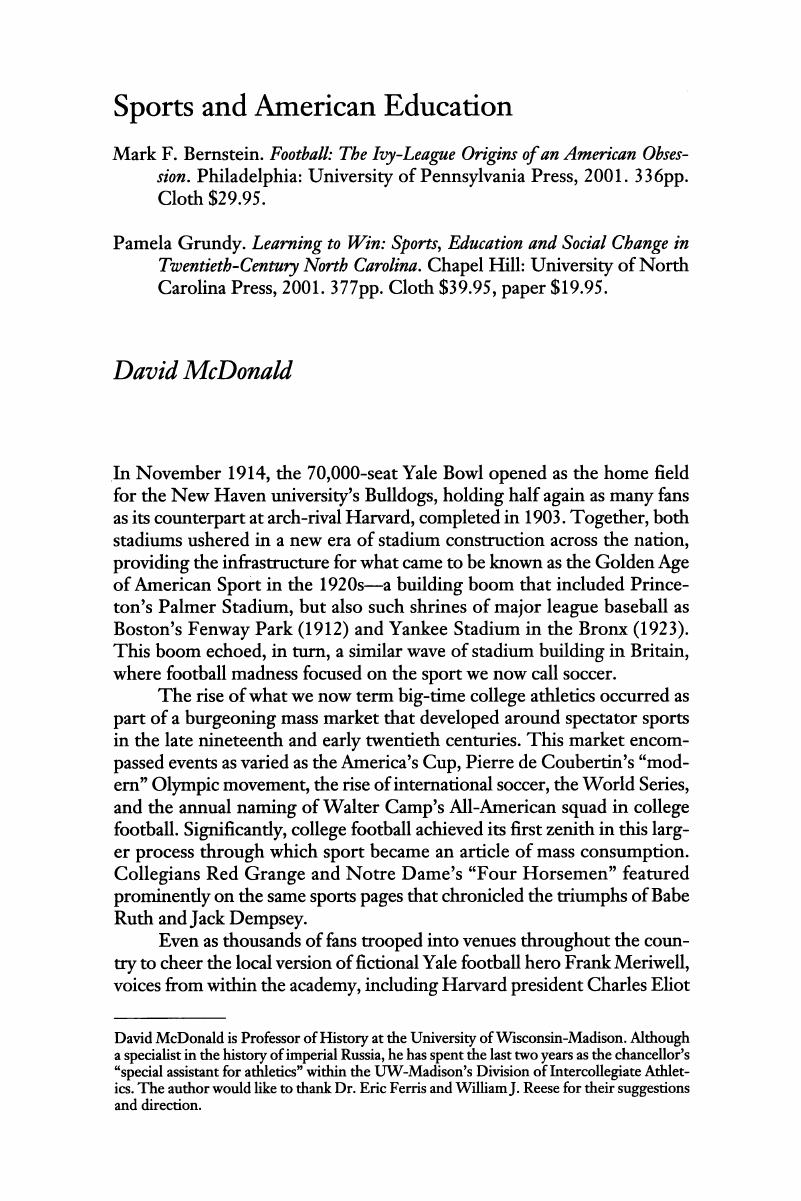No CrossRef data available.
Published online by Cambridge University Press: 24 February 2017

1 For three good accounts of these events and this period in the history of college football, see Ronald Smith, Sports and Freedom: The Rise of Big-Time College Athletics (New York: Oxford University Press, 1988): Michael Oriard, King Football: Sport and Spectacle in the Golden Age of Radio and Newsreels, Movies and Magazines, the Weekly and the Daily Press (Chapel Hill: University of North Carolina Press: 2001); and John Sayle Watterson, College Football: History, Spectacle, Controversy (Baltimore: Johns Hopkins University, 2000).Google Scholar
2 Savage, H. J. et al., American College Athletics (New York: The Carnegie Foundation for the Advancement of Teaching, 1929); Knight Foundation Commission on Intercollegiate Athletics, Keeping Faith with the Student-Athlete: A New Model for Intercollegiate Athletics (March, 1991); idem, A Call to Action: Reconnecting College Sports and Higher Education (Miami: June, 2001).Google Scholar
3 Along with Smith, Ronald (see note 1 above), John Thelin is the most serious among current historians of university athletics in the United States. See his Games Colleges Play: Scandals and Reform in Intercollegiate Athletics (Baltimore: Johns Hopkins University Press, 1994). Sperber is a well-known and ardent critic of current practices in intercollegiate athletics. He is also a prolific and often rousing author in this area, although his analysis often betrays an absence of the historical training evident in Thelin and Smith. See especially his Shake Down the Thunder: The Creation of Notre Dame Football (New York: Henry Holt, 1993) and Onward to Victory: The Crises that Shaped College Sports (New York: Henry Holt, 1998). I omit here reference to the vast mainstream of “histories” on college football, which offer glowing encomia to the heroic traditions of the gridiron and very little by way of criticism. In the context of this literature, Bernstein offers a very balanced and reflective account. On the origins of this literature, see Oriard, op. cit. or ReadingFootball: How the Popular Press Created an American Spectacle (Chapel Hill: University of North Carolina Press, 1993). Historians in other specialties will already have noted the moralisant tone that pervades the titles in even the academic entrants within this genre.Google Scholar
4 Veysey, L. R. The Emergence of the American University (Chicago: University of Chicago Press, 1965).Google Scholar
5 See, most interestingly, this connection drawn explicitly and emphatically in Henry S. Pritchett's introduction to Savage et al., American College Athletics. Google Scholar
6 See the discussion of this period in Watterson, College Football, 209–218.Google Scholar
7 Edwards, Harry Sociology of Sport (Homewood, IL: Dorsey Press, 1973) is the most widely known study from this period.Google Scholar
8 Shulman, J. L. and Bowen, William G. The Game of Life: College Sports and Educational Values (Princeton: Princeton University Press, 2001).Google Scholar
9 Sperber, Murray Beer and Circus: How Big-Time College Sports is Crippling Undergraduate Education (New York: Henry Holt, 2000).Google Scholar
10 Zimbalist, Andrew S. Unpaid Professionals: Commercialism and Conflict in Big-Time College Sports (Princeton: Princeton University Press, 1999), Allen Sack and Ellen Staurowsky, College Athletes for Hire: the Evolution and Legacy of the NCAA's Amateur Myth (Westport, CT: Praeger, 1998).Google Scholar